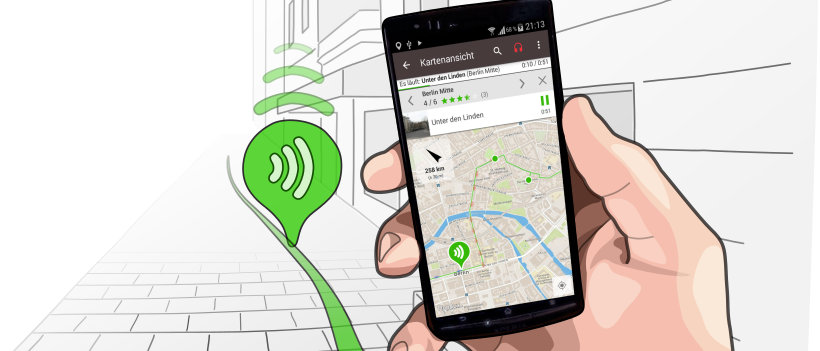We have already discovered a lot on our walk through the estate. You have seen the Houses with Balcony Access built in 1930 and other buildings.
Now we come to the actual origins of the estate, the 316 single-family houses with which Walter Gropius laid the foundation between 1926 and 1928. Just walk down the street called “Doppelreihe” and look at the houses in the estate – I’ll tell you about them as we go.
The buildings you see on the right and left are not only architecturally exciting, but also testify to a “grand vision” – and how difficult it can sometimes be to implement innovative ideas.
When Gropius began planning the housing estate, Bauhaus had just relocated from Weimar to Dessau. In the mid-1920s, Dessau was the capital of the Free State of Anhalt and an up-and-coming industrial metropolis. Since the founding of the Weimar Republic, the city and state had been governed consistently by liberal and social democrats. Dessau seemed to offer ideal conditions for implementing Bauhaus director Walter Gropius’s visionary ideas. The city of Dessau supported the establishment of the design school, financed the buildings for the school, provided it with a generous budget, and arranged concrete commissions.
One of these commissions – and probably the most important – was the planning of a residential estate in the south of the city, the Törten estate. Many thousands of people were registered as “looking for housing” in Dessau, and so great things were expected from Bauhaus.
Gropius had a clear idea of how to create affordable housing. He wanted houses to be produced on an assembly line, similar to cars in a factory – efficiently, cost-effectively, and with a high degree of standardization. He dreamed of a “building kit on a large scale.” These ideas applied to the design of the buildings and the entire construction site organization.
Pre-manufactured components, including lightweight hollow blocks for the walls, were to be delivered directly to the construction site. These blocks were well insulated and designed for easy assembly. Windows, doors, and other elements were also to be standardized so that they could be installed quickly. Every step was carefully thought out – almost like in a factory. This was intended to save time, money, and resources – and make the construction method extremely efficient.
However, the Törten housing estate not only reflected Gropius’s vision of industrial construction, but also his clear design language. The simple buildings with their flat roofs, large window fronts, and functional emphasis followed the principle that design should be minimalist. The aesthetic broke radically with traditional models. With these buildings, Gropius successfully wrote himself into architectural history. But as groundbreaking as the ideas were, Gropius and the Bauhaus also had to endure setbacks.
Shortly after the houses were completed, there were complaints about construction defects. And many of the first residents found the houses impractical. Gropius’ design was very formal and not very functional. For example, many residents found the sills of the living room windows too high, as they blocked the view of the street. In almost all of the houses, the windows were later lowered. Today, you can only see the original ribbon of windows on two houses in the street. Have you spotted them yet? In addition, the houses offered little luxury: there was an outhouse and no bathroom, and residents had to wash themselves in the kitchen.
However, the biggest drawback of the Gropius houses was that, contrary to what had been promised, they were more expensive than comparable houses in other housing estates. Gropius was unable to implement the industrial construction production he had envisaged, even though it was staged on the construction site to great media effect. The promised savings could not be realized. In fact, the Gropius housing estate was a failure. In January 1928, more than 1,000 “Gropius settlers” who felt cheated protested in Dessau. Those politically responsible also felt deceived. The Social Democrats, who had brought Bauhaus to Dessau, withdrew their political support, which was to have painful consequences, particularly in the conflicts with the growing National Socialists. Ultimately, the failure in Törten was one of the reasons why Gropius resigned from his post as director of the Bauhaus in 1928.
Almost 100 years later, the Gropius houses are still inhabited and a living part of the settlement. They are home not only to Bauhaus enthusiasts and art lovers, but mostly to “normal” people. Many houses have been extensively remodeled, and some have been carefully renovated in recent years. But despite all the changes, the original idea remains recognizable: a strict architectural language designed to provide affordable living space.
Today, Gropius’s buildings, such as the Bauhaus Houses with Balcony Access and Paulick’s row houses, are part of the UNESCO World Heritage Site. They are witnesses to classical modernism and milestones in architectural history.
We believe that the Bauhaus buildings show how bold ideas can revolutionize construction – even if not everything could be perfectly implemented. The clear design language and innovative construction methods inspire architects around the world to this day. The social aspirations should also be an inspiration.
Finally, we would like to show you some more buildings from the “classical modernism” period of the estate, namely the houses designed by Leopold Fischer in the easternmost part of Törten. This is our last stop. On the way there, you can take a closer look at the Gropius buildings. If you look closely, you will surely be able to identify the three different types of houses …
Gropius-buildings
De l'audiowalk Audio walk around the Houses with Balcony Access of the Bauhaus settlement | Dessau

12
Stations
49:41 min Audio
2.68 km 16
49:41 min Audio
2.68 km 16


